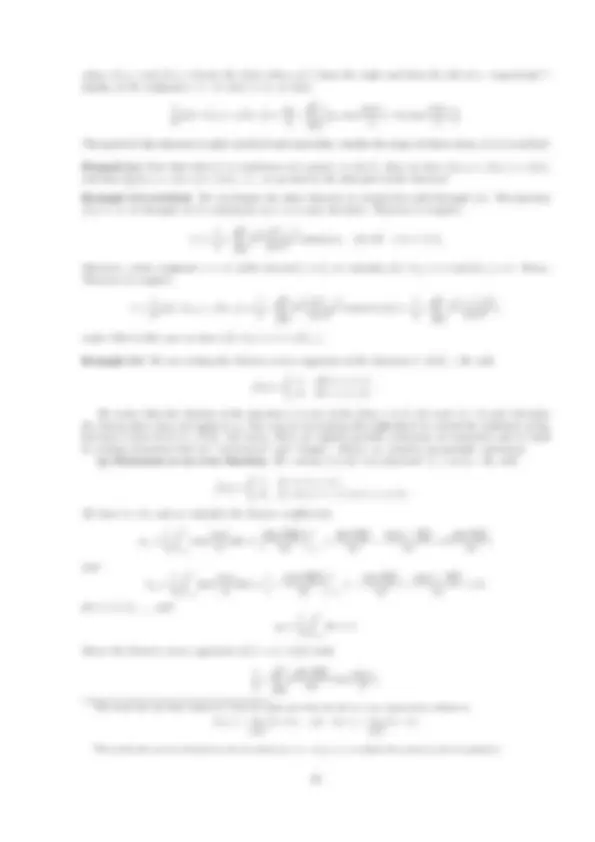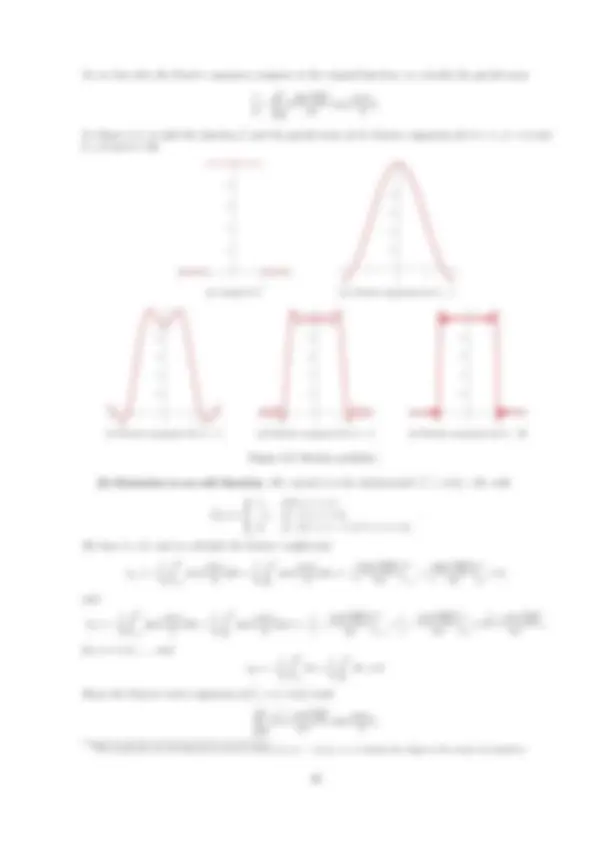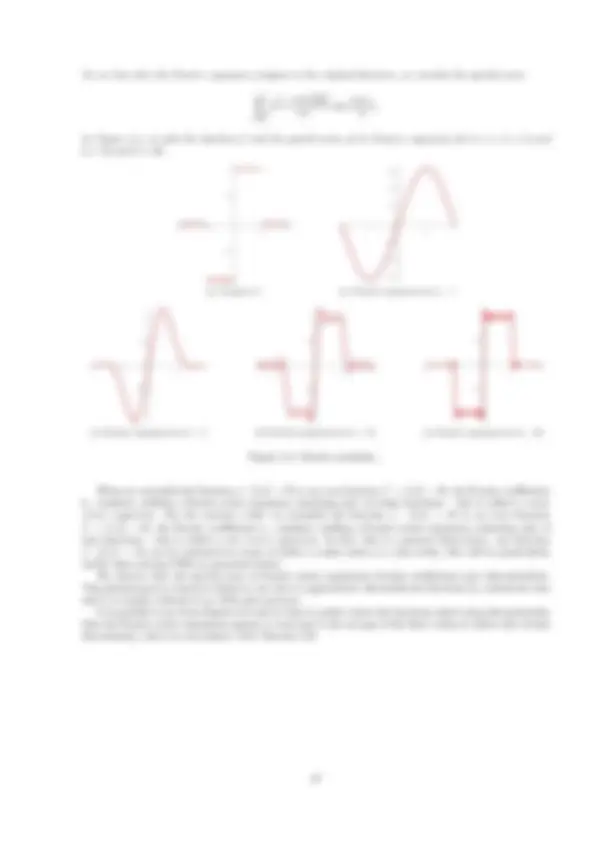





Study with the several resources on Docsity

Earn points by helping other students or get them with a premium plan


Prepare for your exams
Study with the several resources on Docsity

Earn points to download
Earn points by helping other students or get them with a premium plan
Community
Ask the community for help and clear up your study doubts
Discover the best universities in your country according to Docsity users
Free resources
Download our free guides on studying techniques, anxiety management strategies, and thesis advice from Docsity tutors
In this document, we explore Fourier series expansions, which allow representing functions as sums of simpler trigonometric functions (sine and cosine). The Fourier series expansion of a function is defined by its Fourier coefficients, calculated using integration formulas. an example of finding the Fourier series expansion of the absolute value function, and discusses the theorem that guarantees the convergence of Fourier series expansions under certain conditions.
Typology: Lecture notes
1 / 5

This page cannot be seen from the preview
Don't miss anything!




In applied mathematics, it is often of great interest to be able to describe functions in terms of simpler functions. For instance, the classical theory of Power Series is concerned with representing functions as infinite sums of simpler polynomial functions, e.g., the exponential function is known to satisfy
ex^ = 1 + x + x^2 2
x^3 6
xn n!
n=
xn n!
i.e., the function f (x) = ex^ can be written as an infinite sum of multiples of powers of x! Such representations can be very useful in various applications, such as in the solution of ordinary differential equations. In this section, we investigate the question of describing functions in terms of simpler trigonometric functions; these are the celebrated Fourier series expansions^3. In physical terms they can be interpreted as analysing a function into simple sine and cosine functions (waves) of different frequencies. This is a very general and powerful idea; indeed, Fourier series are at the heart of many applications such as signal processing and medical imaging.
Definition 2.1 For L > 0 constant, let f [−L, L] → R be a function with at most finite number of disconti- nuities in the interval [−L, L]. The Fourier series expansion associated with f is defined as
a 0 2 +
n=
an cos
( (^) nπx L
( (^) nπx L
where an and bn, n = 1, 2 ,... , are called the Fourier coefficients and given by the formulas
an :=
−L
f (x) cos
( (^) nπx L
dx, and bn :=
−L
f (x) sin
( (^) nπx L
dx.
We investigate the above definition with an example.
Example 2.2 We are seeking the Fourier series expansion of the function f : [− 1 , 1] → R, with f (x) = |x|. We have L = 1, and we calculate the Fourier coefficients:
an =
− 1
|x| cos(nπx)dx =
− 1
(−x) cos(nπx)dx +
0
x cos(nπx)dx
− x sin(nπx) nπ
− 1
− 1
sin(nπx) nπ dx +
x sin(nπx) nπ
0
0
sin(nπx) nπ dx
= 0 +
cos(nπx) (nπ)^2
− 1
cos(nπx) (nπ)^2
0
1 − (−1)n (nπ)^2
(−1)n^ − 1 (nπ)^2
(−1)n^ − 1 (nπ)^2
and
bn =
− 1
|x| sin(nπx)dx =
− 1
(−x) sin(nπx)dx +
0
x sin(nπx)dx
x cos(nπx) nπ
− 1
− 1
cos(nπx) nπ dx^ +
− x cos(nπx) nπ
0
0
cos(nπx) nπ dx
= (−1)n nπ
[ (^) sin(nπx) (nπ)^2
− 1
(−1)n nπ
[ (^) sin(nπx) (nπ)^2
0
for n = 1, 2 ,... , and
a 0 =
− 1
|x|dx =
− 1
(−x)dx +
0
xdx = 1.
Hence the Fourier series expansion of f (x) = |x|, x ∈ [− 1 , 1] reads
1 2
n=
(−1)n^ − 1 (nπ)^2 cos(nπx).
(^3) The name refers to the great French mathematician and physicist Jean Baptiste Joseph Fourier (1768 - 1830) who first proposed solving PDEs using trigonometric series expansions.
To see how does the Fourier expansion compares to the original function, we consider the partial sums
1 2
∑^ k n=
(−1)n^ − 1 (nπ)^2 cos(nπx);
then, for k = 1, we get 1 2 −^
π^2 cos(πx), for k = 3, we get 1 2
π^2 cos(πx) −
9 π^2 cos(3πx),
and so on (notice that the terms for n even are zero). In Figure 2.2, we plot the function f (x) = |x| and the partial sums of its Fourier expansion for k = 1, k = 3 and k = 7.
0
1
–1 –0.8 –0.6 –0.4 –0.2 0.2 0.4 0.6 0.8 1 x (a) Graph of f (x) = |x|
–1 –0.8 –0.6 –0.4 –0.2 0 0.2 0.4 0.6 0.8 1 x (b) Fourier expansion for k = 1
–1 –0.8 –0.6 –0.4 –0.2 0 0.2 0.4 0.6 0.8 1 x (c) Fourier expansion for k = 3
–1 –0.8 –0.6 –0.4 –0.2 0 0.2 0.4 0.6 0.8 1 x (d) Fourier expansion for k = 7
Figure 2.2: Fourier synthesis...
The first question that may spring to mind is: does it hold
f (x) = a 0 2
n=
an cos
( (^) nπx L
( (^) nπx L
In the previous example, this seemed to be the case, as we take more and more terms in the series. The following theorem gives an answer to the above question.
Theorem 2.3 Suppose that a function f : [−L, L] → R and its derivative f ′^ are bounded and continuous everywhere in [−L, L] apart from a finite number of points. Then, at every point x ∈ (−L, L) for which f is continuous, we have
f (x) = a 0 2 +
n=
an cos
( (^) nπx L
( (^) nπx L
at every point x ∈ (−L, L) that f has a jump discontinuity, we have
1 2
f (x+) + f (x−)
= a^0 2
n=
an cos
( (^) nπx L
( (^) nπx L
To see how does the Fourier expansion compares to the original function, we consider the partial sums
1 2
∑^ k n=
sin
( (^) nπ 2
nπ cos
( (^) nπx 2
In Figure 2.3, we plot the function f˜ and the partial sums of its Fourier expansion for k = 1, k = 3 and k = 9 and k = 39.
0
1
–2 –1 1 2 x (a) Graph of f˜
1
–2 –1 1 2 x (b) Fourier expansion for k = 1
1
–2 –1 1 2 x (c) Fourier expansion for k = 3
1
–2 –1 1 2 x (d) Fourier expansion for k = 9
1
–2 –1 1 2 x (e) Fourier expansion for k = 39
Figure 2.3: Fourier synthesis...
(b) Extension to an odd function. We extend f to the odd function^6 fˆ : [− 2 , 2] → R, with
f^ ˆ (x) =
1 , if 0 ≤ x ≤ 1 ; − 1 , if − 1 ≤ x < 0 ; 0 , if − 2 ≤ x < − 1 or 1 < x ≤ 2.
We have L = 2, and we calculate the Fourier coefficients:
an = −
− 1
cos
( (^) nπx 2
dx +
0
cos
( (^) nπx 2
dx = −
[ (^) sin (^ nπx 2
nπ
− 1
[ (^) sin (^ nπx 2
nπ
0
and
bn = −
− 1
sin
( (^) nπx 2
dx +
0
sin
( (^) nπx 2
dx = −
cos
( (^) nπx 2
nπ
− 1
cos
( (^) nπx 2
nπ
0
1 − cos
( (^) nπ 2
nπ
for n = 1, 2 ,... , and
a 0 = − 1 2
− 1
dx +^1 2
0
dx = 0.
Hence the Fourier series expansion of fˆ , x ∈ [− 2 , 2] reads
∑^ ∞ n=
1 − cos
( (^) nπ 2
nπ sin
( (^) nπx 2
(^6) We recall that an odd function is one for which f (−x) = −f (x), i.e., it admits the origin as the centre of symmetry.
To see how does the Fourier expansion compare to the original function, we consider the partial sums
∑^ k n=
1 − cos
( (^) nπ 2
nπ sin
( (^) nπx 2
In Figure 2.4, we plot the function fˆ and the partial sums of its Fourier expansion for k = 1, k = 3 and k = 10 and k = 40.
–0.
1
–2 –1 1 2 x
(a) Graph of fˆ
–0.
–0.
–0.
0
–2 –1 1 2 x
(b) Fourier expansion for k = 1
–0.
0
1
–2 –1 1 2 x
(c) Fourier expansion for k = 3
–0.
1
–2 –1 1 2 x
(d) Fourier expansion for k = 10
–0.
0
1
–2 –1 1 2 x
(e) Fourier expansion for k = 40
Figure 2.4: Fourier synthesis...
When we extended the function f : [0, 2] → R to an even function f˜ : [− 2 , 2] → R, the Fourier coefficients bn vanished, yielding a Fourier series expansion consisting only of cosine functions – this is called a cosine series expansion. On the contrary when we extended the function f : [0, 2] → R to an even function fˆ : [− 2 , 2] → R, the Fourier coefficients an vanished, yielding a Fourier series expansion consisting only of sine functions – this is called a sine series expansion. In fact, this is a general observation: any function f : [0, L] → R can be expressed in terms of either a cosine series or a sine series; this will be particularly useful when solving PDEs as presented below. We observe that the partial sums of Fourier series expansions develop oscillations near discontinuities. This phenomenon is common whenever one tries to approximate discontinuous functions by continuous ones and it is usually referred to as Gibbs phenomenon. It is possible to see from Figures 2.3 and 2.4 that at points where the functions admit jump discontinuities then the Fourier series expansions appear to converge to the average of the limit values at either side of each discontinuity; this is in accordance with Theorem 2.3!